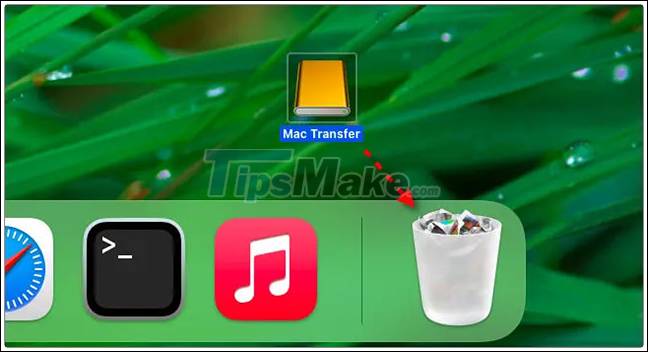5 ways to securely disconnect a removable hard drive on a Mac
Here are 5 ways to easily, safely and quickly disconnect a removable hard drive on your Mac.
Why do you need Eject secure drives on Mac
Eject is a necessary step to prevent data loss when you suddenly disconnect your hard drive or removable storage device (memory card, USB) from your computer. More specifically, to speed up data transfer to external storage devices, macOS sometimes writes data to a temporary location in memory instead of writing it to the storage device. If you unplug the removable hard drive before the data is written, data loss is inevitable.
When you right-click on the removable hard drive you want to disconnect and click 'Eject', the temporary recording will complete, writing 100% of the data to the actual device. After you officially disconnect the drive from the system, no data will be lost.
Method 1: Drag the Drive icon into Trash
 5 ways to securely disconnect a removable hard drive on a Mac Picture 1
5 ways to securely disconnect a removable hard drive on a Mac Picture 1
One of the most common ways to safely disconnect a removable hard drive on a Mac is to drag it to the Trash section.
To do so, the removable hard drive must be visible on your home screen. To safely disconnect, simply click and drag the icon of the removable hard drive to the Trash section. While dragging, the Trash trash icon will change to an Eject icon. When you release the pointer, the removable hard drive will be safely disconnected.
Tip: If you don't see the icon of the removable hard drive on the home screen, you can do the following setup steps to make it appear. First, bring Finder to the foreground, then click on Finder> Preferences in the menu bar (or press Command + Comma on your keyboard). When the Finder Preferences opens, select the 'General' tab. Next, check the items you want to appear on the home screen.
Method 2: Eject from the menu bar
 5 ways to securely disconnect a removable hard drive on a Mac Picture 2
5 ways to securely disconnect a removable hard drive on a Mac Picture 2
You can also safely disconnect the hard drive from your Mac using an option available on the menu bar at the top of the screen.
First, click on the removable hard drive you want to Eject on your home screen or in Finder, and then on the top menu bar, choose File> Eject.
Method 3: Eject from Finder
 5 ways to securely disconnect a removable hard drive on a Mac Picture 3
5 ways to securely disconnect a removable hard drive on a Mac Picture 3
Securely disconnecting a removable hard drive can also be done easily in the Finder. Simply open any Finder window, then expand the 'Locations' section of the sidebar menu. Next, click the small Eject icon next to the name of the removable hard drive in the drop-down list. It's done!
Method 4: Right click on the hard drive icon
 5 ways to securely disconnect a removable hard drive on a Mac Picture 4
5 ways to securely disconnect a removable hard drive on a Mac Picture 4
With this method, simply click the icon of the removable hard drive you want to safely disconnect in the Finder or on the home screen. Then right click on this icon with your mouse or trackpad. In the menu that appears, select the 'Eject' option.
Method 5: Press Command + E
And finally, you can safely disconnect the hard drive from your Mac using a keyboard shortcut.
First, click the drive icon (on the home screen, in a Finder window or in the sidebar of the Finder) and press the Command + E key combination. The hard drive will immediately be safely disconnected from the system. your system.
You should read it
- How to Eject a CD From Your Mac
- Is it necessary to disconnect secure USB devices?
- How to Disconnect a Mapped Network Drive
- Ways to use the Eject button on the Macbook
- How to Uninstall Google Drive on Mac
- How to use an external hard drive with a Chromebook
- How to Properly Eject an iPhone from a Mac
- How to Play a CD on a Desktop Computer
- Difference between Flash drive and Pen drive
- Turn on / off the computer disconnect feature from the network in Windows 10
- How to Format an SSD Drive
- Google Drive 4,2021.46200, Download Google Drive here
May be interested

Apple released macOS Big Sur 11.2.2: Fixed a hardware failure when used with a 3rd party USB-C hub

How to quickly lock your Mac

5 steps to install Windows 10 on a Mac

How to automatically turn off the MacBook keyboard backlight when not in use

A few terms that you should know before you install Hackintosh

Google Sheets keyboard shortcuts on macOS






 Instructions for choosing the best removable SSD hard drive for Macbook today
Instructions for choosing the best removable SSD hard drive for Macbook today Instructions for 5 ways to fix the error of not recognizing the removable hard drive on Windows
Instructions for 5 ways to fix the error of not recognizing the removable hard drive on Windows Review Samsung 850 EVO 500GB - The best removable SSD on the market today
Review Samsung 850 EVO 500GB - The best removable SSD on the market today 5 ways to check hard drive effectively to help periodically check the hard drive
5 ways to check hard drive effectively to help periodically check the hard drive 9 SSDs for the best gaming for gamers
9 SSDs for the best gaming for gamers 8 effective ways to check your hard drive to periodically check the health of your hard drive
8 effective ways to check your hard drive to periodically check the health of your hard drive